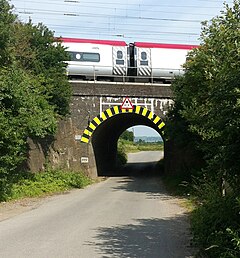
Back سرقة القطار الكبرى Arabic Assalt al tren postal Glasgow-Londres Catalan Velká vlaková loupež Czech Y Lladrad Trên Mawr Welsh Postzugraub German Η Μεγάλη Ληστεία του Τρένου Greek Granda trajnprirabo (1963) Esperanto Asalto al tren postal de Glasgow-Londres Spanish Glasgow-Londres trenaren lapurreta Basque Suuri junaryöstö (1963) Finnish
 Mentmore Bridge (previously known as Bridego Bridge and then Train Robbers' bridge),[1] scene of the robbery | |
| Date | 8 August 1963 |
|---|---|
| Time | Just after 03:00 |
| Location | Bridego Railway Bridge, Ledburn, England |
| Coordinates | 51°52′44″N 0°40′10″W / 51.87889°N 0.66944°W |
| Also known as | Cheddington Mail Van Raid |
| Cause | Train robbery |
| Participants |
|
| Outcome | Theft of £2.61 million (the equivalent of £69 million as of 2024) |
| Non-fatal injuries | Jack Mills (train driver) |
| Charges |
|
| Verdict | Guilty |
| Convictions | 11 men sentenced (Bill Boal and Lennie Field later exonerated) to terms up to 30 years |
The Great Train Robbery was the robbery of £2.61 million[2] (calculated to present-day value of £69 million - or $73,547,750) from a Royal Mail train travelling from Glasgow to London on the West Coast Main Line in the early hours of 8 August 1963 at Bridego Railway Bridge, Ledburn, near Mentmore in Buckinghamshire, England.[3]
After tampering with the lineside signals to bring the train to a halt, a gang of 15, led by Bruce Reynolds, attacked the train. Other gang members included Gordon Goody, Buster Edwards, Charlie Wilson, Roy James, John Daly, Jimmy White, Ronnie Biggs, Tommy Wisbey, Jim Hussey, Bob Welch and Roger Cordrey, as well as three men known only as numbers "1", "2" and "3"; two were later identified as Harry Smith and Danny Pembroke. A 16th man, an unnamed retired train driver, was also present.[4]
With careful planning based on inside information from an individual known as "The Ulsterman", whose real identity has never been established, the robbers escaped with over £2.61 million. The bulk of the stolen money has never been recovered. The gang did not use any firearms, though Jack Mills, the train driver, was beaten over the head with a metal bar and suffered serious head injuries. After his partial recovery, Mills returned to work doing light duties. He retired in 1967 and died in 1970 due to an unrelated illness. Mills never overcame the trauma of the robbery.[5] After the robbery, the gang hid at Leatherslade Farm. The police found this hideout, and incriminating evidence, a Monopoly board with fingerprints,[2] led to the eventual arrest and conviction of most of the gang. The ringleaders were sentenced to 30 years in prison.
- ^ "Pressure makes Network Rail change bridge name". The Railway Magazine. Archived from the original on 19 December 2013. Retrieved 18 December 2013.
- ^ a b "Great Train Robbery". Retrieved 28 January 2023.
- ^ "The Great Train Robbery, 1963". British Transport Police. Archived from the original on 11 August 2013. Retrieved 4 August 2013.
- ^ "The Great Train Robbers: Who were they?". BBC. 18 December 2013. Archived from the original on 22 December 2013. Retrieved 5 January 2014.
- ^ Russell-Pavier, N.; Richards, S. (2013). The Great Train Robbery: Crime of the Century: The Definitive Account. Orion. p. 293. ISBN 978-0-297-86440-0. Retrieved 25 January 2022.
© MMXXIII Rich X Search. We shall prevail. All rights reserved. Rich X Search